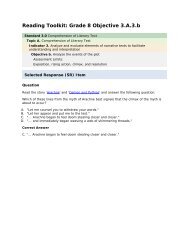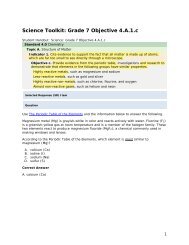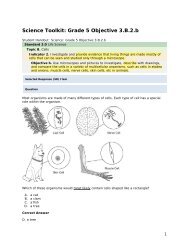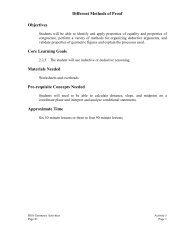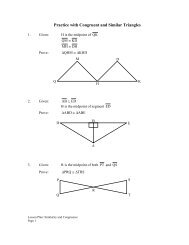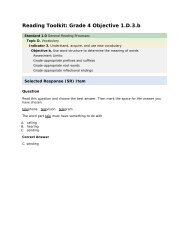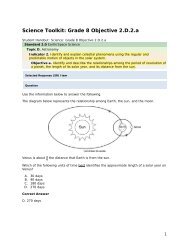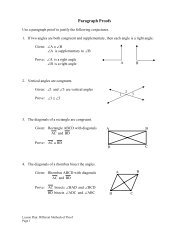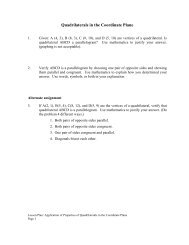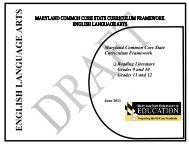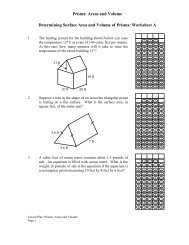Arts Integrated Lesson Plan - mdk12
Arts Integrated Lesson Plan - mdk12
Arts Integrated Lesson Plan - mdk12
You also want an ePaper? Increase the reach of your titles
YUMPU automatically turns print PDFs into web optimized ePapers that Google loves.
Maryland Artist/Teacher<br />
Institute<br />
<strong>Arts</strong> <strong>Integrated</strong><br />
<strong>Lesson</strong> <strong>Plan</strong><br />
ART FORM:<br />
Theatre<br />
SUBJECT AREA:<br />
Reading/English Language<br />
<strong>Arts</strong><br />
<strong>Lesson</strong> Title:<br />
Extending plot and understanding character through tableau (Romeo and<br />
Juliet by William Shakespeare)<br />
Contributor, School:<br />
Zachary Johnson, Cedar Chapel School<br />
Grade:<br />
9<br />
Time Frame:<br />
45–60 minutes<br />
State Curriculum Content Standards, Indicators, Objectives<br />
Theatre Content Standard(s)<br />
3.0 Creative Expression and Production:<br />
Students will demonstrate the ability to apply<br />
theatrical knowledge, principles, and practices<br />
to collaborative theatre presentations.<br />
Theatre Indicator(s)<br />
3.1 Apply a variety of dramatic structures to<br />
theatrical presentations.<br />
Theatre Objective(s)<br />
3.1.a Use dramatic narrative conventions to<br />
write and perform monologues, scenes, and<br />
plays that are based on personal experiences,<br />
real or improvised situations, or historical<br />
events.<br />
Reading/English Language <strong>Arts</strong> Content Standard(s)<br />
1.0 General Reading Processes<br />
Topic E: Students will use a variety of strategies to understand<br />
what they read (construct meaning).<br />
Reading/English Language <strong>Arts</strong> Content Indicator(s)<br />
1.4 Use strategies to demonstrate understanding of the text (after<br />
reading).<br />
Reading/English Language <strong>Arts</strong> Content Objective(s)<br />
4.a Identify and explain information directly stated in the text.<br />
4.b Draw inferences and/or conclusions and make<br />
generalizations.<br />
4.c Summarize and paraphrase.<br />
Objective(s) (Connecting the content areas)<br />
Students will create effective tableaux and improvised scenes using the basic acting tools and skills, focusing on<br />
key moments in the play Romeo and Juliet by William Shakespeare that reflect their comprehension of the text,<br />
understanding of the feelings of the characters, ability to predict/infer, and ability to create interior monologues that<br />
fit the characters.<br />
Key <strong>Arts</strong> Vocabulary<br />
tableau, interior monologue<br />
Key Reading English Language <strong>Arts</strong> Vocabulary<br />
prediction/inference<br />
Prior Knowledge Students Need for This <strong>Lesson</strong><br />
<strong>Arts</strong><br />
• Acting tools and skills<br />
• Tableau<br />
Reading/English Language <strong>Arts</strong><br />
• The plot of the play<br />
• The sequence of events in the play<br />
MATI <strong>Arts</strong> <strong>Integrated</strong> <strong>Lesson</strong> <strong>Plan</strong> 1<br />
copyright © 2010 msde
Materials and Resources<br />
Materials and Resources for the Class<br />
Romeo and Juliet by William Shakespeare<br />
Materials and Resources for the Teacher<br />
Selected scenes from Romeo and Juliet by William Shakespeare<br />
MATI <strong>Arts</strong> <strong>Integrated</strong> <strong>Lesson</strong> <strong>Plan</strong> 2<br />
copyright © 2010 msde
<strong>Lesson</strong> Development/Procedures (including motivation, modeling, guided practice, and independent<br />
practice)<br />
• Students will participate in acting tool and skill building activities to prepare them for the lesson.<br />
• The teacher will provide students with a brief synopsis of a scene previously covered from the play<br />
Romeo and Juliet by William Shakespeare.<br />
• Students will work in small groups or pairs. They will discuss the scene and create a tableau that<br />
captures the key moment and emotions the characters feel in the scene.<br />
• Then students will plan an improvised scene in which they predict/infer what could happen next after the<br />
moment in the play. The improvisation should last no more than one minute. All characters in the scene<br />
should speak. The improvised scene should end in a final tableau. The students should be prepared to<br />
share a brief internal monologue (30 seconds) that includes the feelings of the character when the<br />
teacher uses the “Shoulder Tap” for the final tableau.<br />
• The students will receive a rubric of what needs to be included in the tableau and scene as they plan.<br />
This rubric will serve as an assessment and scoring tool for the assignment.<br />
• Students will present the tableau, scene, and internal monologue.<br />
• The teacher will facilitate a reflective discussion about the presentation based on the rubric.<br />
• Students will have an opportunity to revise and redo their presentations.<br />
Closure/Summary<br />
• The teacher will facilitate a reflective discussion about the presentation based on the rubric.<br />
o Students will identify groups that used the rubric criteria well and explain their choices.<br />
o Students will reflect on their own ability to meet the criteria of the rubric and set a personal<br />
goal for improvement for the next lesson using tableaux and/or internal monologue.<br />
• Students will then return to the text to read the next scenes in order to confirm or refute their<br />
predictions.<br />
_________________________________________________________________________<br />
Assessment (Description/Tools)<br />
A rubric that includes the qualities of an effective tableau<br />
• Point of concentration, stillness, levels, use of accurate information, inferred dialogue for the Shoulder<br />
Tap, and a title<br />
The qualities of an effective internal monologue<br />
• Dialogue that accurately reflects the character and the character’s circumstances<br />
• Voice tone, pitch, and expression that fit the character’s personality and feelings as well as the<br />
character’s circumstances<br />
The qualities of an effective inference<br />
• Combines clues from the story with prior knowledge<br />
Reflective discussion on the effectiveness of the scenes and tableaux.<br />
Revisions based on the discussions.<br />
<strong>Lesson</strong> Extensions<br />
• Make further revisions and improvements on the tableaux and scenes.<br />
• Transform the tableaux into a human slide show in which each tableaux is presented in rapid<br />
succession like a PowerPoint or slide show.<br />
MATI <strong>Arts</strong> <strong>Integrated</strong> <strong>Lesson</strong> <strong>Plan</strong> 3<br />
copyright © 2010 msde
MATI <strong>Arts</strong> <strong>Integrated</strong> <strong>Lesson</strong> <strong>Plan</strong> 4<br />
copyright © 2010 msde




